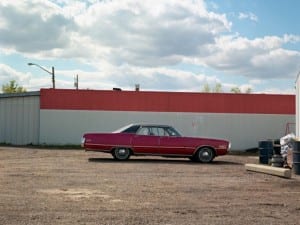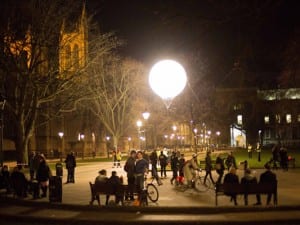Shimmering eclectic waves, the magic of visual oceans high up a ceiling, endless skies of light flickering and changing in time, impressions created by the new LivingSculpure 3D Module System by Christopher Bauder from WHITEvoid. The award winning and Berlin based designer has teamed up with PHILIPS to design a revolutionary modular system of light installation by using OLED’s (Organic Light Emitting Diodes), a breakthrough in lighting that fascinate by their endless possibilities to create new forms of light as they are emitting light in form of super flat (1,8mm) panels when electricity is applied. The new technology has made possible what Christopher Bauder’s dream in design has always been: using technology and transferring bits and bytes into real spaces of offices, museums, bars, and airports and by re-interpreting this light technology in his art and design. Aesthetica spoke to Christopher about The LivingSculpture 3D Module System.
A: Firstly, tell us about The LivingSculpture 3D Module System.
CB: The LivingSculpture 3D Module System is the second product that we designed for the Philips LivingSculpture product family. For both products we used the ultra-thin and reflective Philips Lumiblade OLEDs (organic light emitting diode). For the LivingSculpture 3D Module System we attempted to treat light and the light source respectively as a material by itself. This material can then be used to create three dimensional surfaces and shapes. We broke the system down into a DIY kit like structure consisting of a base module with plug holes, extension rods of flexible length and a rectangular OLED light head. In addition we designed and programmed an online configuration tool that allows lighting designers to create and order their own and very individual version of the system. We also designed and programmed an iPad controlled lighting software that allows to create individual mood and animated light settings for the final installation. The basic system will be extended in the near future with a variety of different base modules, various OLED head shapes and colours. This will allow designers to create their very own and unique version of the LivingSculpture 3D Module System from almost unlimited combinations and arrangements.
A: What prompted you to team up with PHILIPS to design this revolutionary modular system?
CB: Like every designer working with light, I was curious about this new technology named OLED. So I ordered some samples and researched existing projects that incorporated this technology. But I was rather unsatisfied with existing approaches to put the OLED in a frame and try to somehow use it as a surrogate for light bulbs. I rather saw the qualities of the OLED in its thinness and flexibility in shape, size and arrangement. For me the OLED is not just a passive light emitter, like the LED or the light bulb. The OLED with its reflective surface is strikingly beautiful even when turned off and it has a non-blinding warm light quality when turned on. The LivingSculpture 3D Module System makes full use of those qualities and appears as a very light and almost floating cloud of individual light elements forming a hyper surface altogether. Since we are known for rather unconventional approaches towards lighting through our Kinetic Lights system, Philips approached us to discuss possible applications for this newly created light material. Our heads immediately started spinning and we came up with several ideas for modular OLED light fixtures. Two of them were then realized first as prototypes, then as products by Philips Lumiblade respectively the LivingSculpture Kinetic Installation and the LivingSculpture 3D Module System.
A: Why have you chosen to work with varying technologies and light, what are you hoping to achieve through these media?
CB: I am fascinated by light itself. May it be natural or artificial light. I just love its colour spectrum, intensity and positive vibe. This love for light in combination with my affinity for all sorts of technology is the red line that links most of my personal and WHITEvoid projects. I am interested in using light as a material that can be formed and modified to create something new and unique. I often make use of moving elements to distribute light in space. Sometimes by reflecting and deflecting natural light like in the FLARE facade project or by moving LED and OLED light fixtures in space with our Kinetic Lights system. We also created the LivingSculpture 3D Module System as a flexible and modular DIY product that allows for individual distribution and animation of light in three dimensions.
A: Transferring your designs in to real spaces such as offices, bars, museums and airports is integral to your practice, can you expand on this?
CB: All of our designs are produced on a computer with 3D software. So naturally a lot of our inspiration comes from elements within the computer realm like pixels, polygons, vectors …etc.. But even the best computer simulation does not get even somewhere close to the impact our installations have on people in the real physical world. People who have seen the renderings or video documentations of our projects before, often say that the impression the actual installation leaves is so much stronger than they expected. Computers can calculate and simulate the properties of light, but the impact a real physical light source has on our eyes, brain and feelings cannot be replaced by a simulation yet. So for me it is very important to see people’s immediate reactions to our installations and hopefully witness the best feedback you can get: a smile when we turn on the lights.
A: What were your main concerns when making The LivingSculpture 3D Modules System?
CB: Our main concern was to keep the quality of the final product consistent with the initial design and the prototypes. But the Philips engineers do a very good job in maintaining the visual quality while reducing complexity and production costs of the individual parts. The product looks and feels exactly like we initially envisioned it. The reflections of the light on the chromed surfaces are even more beautiful than we hoped for. It produces a very nice depth impression when light animations flicker across the arrangement. We were also not sure about the overall amount of light emitted from the installation surface, but we were surprised by the brightness and brilliance of the final test arrangement.
A: What is interesting with this, is that you have eliminated the need for technical expertise when creating The LivingSculpture 3D Module System. Is this something you look towards incorporating in the future?
CB: We are always interested in creating modular and flexible systems that also allow others to realize their own individual visions within. It is nice to see that an outside view often brings new impulses and ideas that we initially did not think of. Every day we get requests and sketches from other designers that take our ideas and concepts a step further or modify them to a complete new direction. We designed the Kinetic Lights System, The Polygon Playground, The FLARE facade or the LivingSculpture 3D Module System as basic principles that can be used and modified by others to expand and develop the initial idea. This creative feedback also helps us to design new systems for designers.




